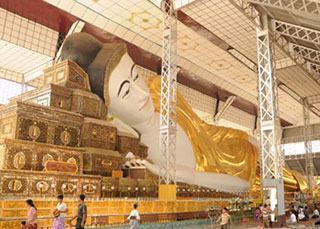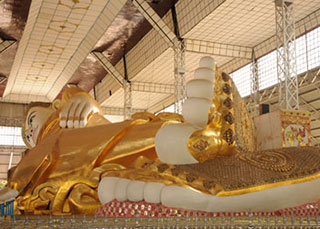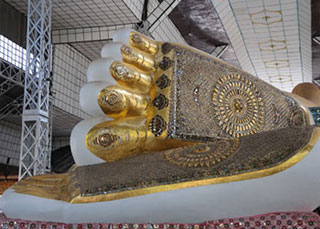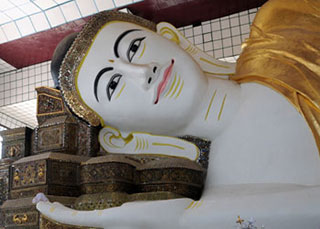Of the Buddha images and statues found in Myanmar. the sitting. standing and reclining styles are the three major iconographic postures. In the sitting posture we find two variations – sitting crosslegged on the lotus blosom motif. and sitting on a chair-like throne with the legs straight down. The standing postures are of two types. standing (walking) with an alms bowl in the right hand. followed by the disciples holding their alms bowls in their hands. and standing still with a smile on the face. the right hand raised. with the index finger pointing somewhere.
Usually the statue of his cousin Shin Ananda in the sitting and listening position is found by the side of such a standing and pointing Buddha statue. The meaning is that the Buddha is giving his divine prophecy to Shin Ananda. In the case of the reclining style. there are four variations. If the reclining Buddha statue’s head is laid to the east. with the hand or a cushion supporting the head. it is called Paung laung Buddha. If the head is laid to the west it is called Tharaban Buddha; if to the south. it is called Tha lyaung Buddha. If the head is laid to the north. without support under it and the eyes are closed. it is called Maha Parinibban Buddha (the Buddha’s Demise).


Most reclining Buddha images found in Myanmar are of Tha Lyaung type. Except for the Mahaparinibban type. all are of the Tha Lyaung type regardless of their heads’ direction. They are relaxing postures. The Buddha had recommended that “sitting. standing. walking and reclining are good exercises for physical fitness”.
There are more than one reclining or lying Buddha statues in Myanmar. Those of large size are two at ancient Bagan. made of brick and plaster. two at Mandalay. one hewn out of an alabaster monolith. and the other of brick and cement. one at old Tada U town. made of brick and plaster. one at Hinthada. made of brick and plaster. one at Dawei. and one at Myeik. both made of brick and plaster. one in Yangon made of brick and cement and two in Bago. made of brick and plaster. Two more reclining Buddha statues are under construction. one near Myowa in Sagaing Division. and the other in the Mon State. each claiming that it would be the largest of the type when finished. Both are being carved out of the hill range.
Among the eleven reclining Buddha statues mentioned above. the Shwe Tha Lyaung Statue at Bago is publicly acclaimed the oldest and largest. The other reclining Buddha statue at Bago is named Sein Tha Lyaung which is half the size of the former. Legend has it that the Shwe Tha Lyaung Statue was made by King Miga Depa (Junior) in A.D. 994. The Statue to – day (1997) is 1003 years old! Miga Depa was the 13th ruler in the long dynasty of over thirty kings. Time was when animism and spirit worship were rampant in the kingdom. untill his daughter-in-law. a Mon Princess named Dalla Htaw introduced and propagated Buddhism. The King. the court. and all his subjects became Buddhist.


In the Myanmar Era 356 (A.D. 994) King Miga Depa made a large reclining Buddha statue on the hillock called Dei Ka Lun which at that time was forested with sandalwood trees. The original Statue was 120 (Than Taung) cubits (180 feet) long. Though subsequent Buddhist kings had maintained and worshipped the sacred Statue. in the dark periods of history. the sacred object being left in neglect. was exposed to the elements of nature. After being covered with earth and luxuriant vegetation. “it came to assume the form of a wooded hillock”. totally lost in oblivion.
Its discovery was a chance find. When the railways were about to be extended to Bago. earth and bricks were needed for landfilling and construction of bunds and bridges. When an Indian contractor began digging the “wooded hillock” for the supply of earth. the great reclining Statue appeared in a dilapidated condition. Due to a storm of protests by the Buddhists. particularly those who were conversant with the history of ancient Bago. the contractor’s work was called to a halt. The restoration of the sacred Statue was immediately taken in hand. By 1881. the Shwe Tha Lyaung reclining Buddha Statue was completely restored to its original style and splendour. In 1903. the iron pavalion was constructed to shelter it.
No visitor to Bago should miss seeing and marvelling at this gigantic Buddha Statue in the recumbent position. and no one will deny that it is a superlative size after he reads the following dimensions of the Colossus:
Description of Part Feet Meter
Length 180ft 54.88 meters
Height 52 ½ ft 16 meters
Face 22 ½ ft 6.86 meters
Ear 15 ft 4.57 meters
Eye 3 ¾ ft 1.14 meters
Eyebrow 7 ½ ft 2.29 meters
Eyelid 7 ½ ft 2.29 meters
Nose 7 ½ ft 2.29 meters
Lip 7 ½ ft 2.29 meters
Neck 7 ½ ft 2.29 meters
Shoulder to waist 47 ½ ft 14.48 meters
Waist to knee 47 ½ ft 14.48 meters
Knee to foot 47 ½ ft 14.48 meters
Elbow to tip of Finger 45 ft 13.71 meters
Little Finger 10 ft 3.05 meters
Sole of foot 25 ½ ft 7.77 meters
Great toe 6 ft 1.83 meters
Palm of Hand 22 ft 6.71 meters
Dr. Khin Maung Nyunt
